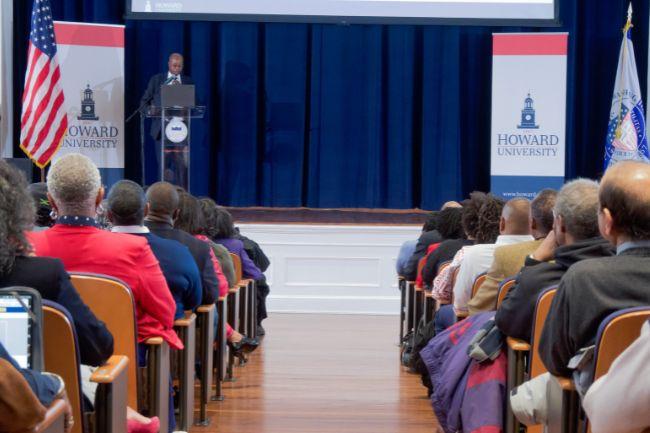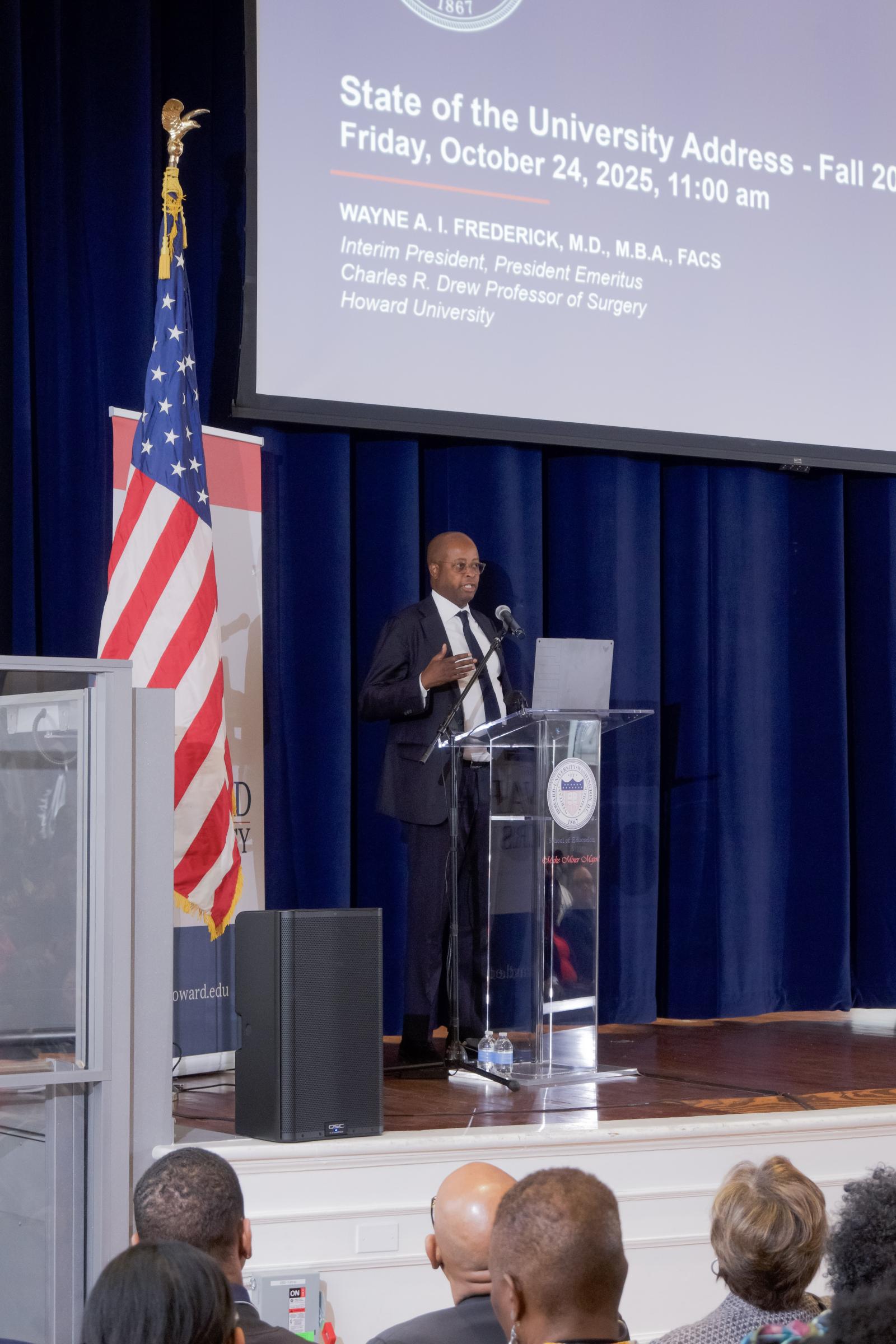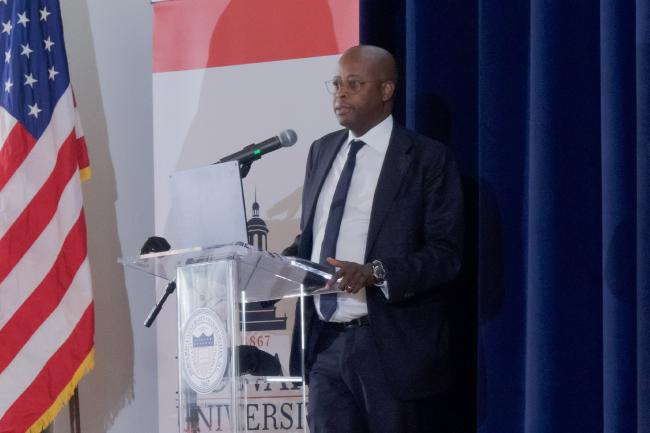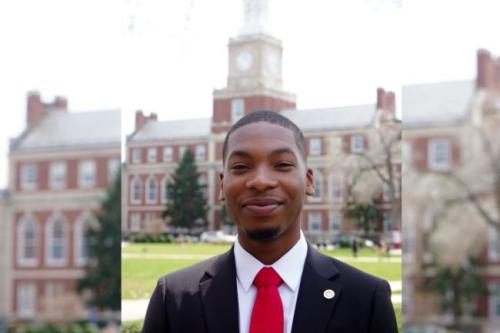
On Friday, October 24, faculty, students, staff, and alumni all gathered in the auditorium of the Myrtilla Miner Building to hear Howard University Interim President, President Emeritus, and Charles R. Drew Professor of Surgery Wayne A. I. Frederick deliver the State of the University Address. The address, began by Frederick during his tenure as the 17th president of the university, provided a clear-eyed view of the goals of the university’s administration and plans for the future.
Dean of the School of Education Dawn Williams kicked off the address by welcoming attendees and acknowledging that the event was also a homecoming for the School of Education and Howard University Middle School of Mathematics & Science, which moved into the newly renovated Miner Building last year. She then introduced Dr. Frederick, highlighting his lifelong dedication to Howard, from his enrollment as a freshman at the age of 16 through his decades of leadership, including service as provost, chief academic officer, and director of the Howard University Hospital Cancer Center.

An Honest, Open Dialogue
Dr. Frederick opened his address by acknowledging several colleagues in attendance, including Howard's Board of Trustees, cabinet, deans, and new faculty, along with the Middle School's principal and board chair. He also honored the legacies of Dr. James Weldon Norris and Dr. Jeanne Craig Sinkford, two groundbreaking faculty members who passed away earlier this year.
Dr. Frederick then dove into some of the most pressing issues facing the university, including low Black male enrollment, recent concerns with student accounts, the importance of supporting the university’s research community, and the effects of the government shutdown on Howard’s funding.
Prioritizing Student Success
Opening with a discussion of the administration’s goal to prioritize student success and assistance, he acknowledged challenges the university faced and missed opportunities to better communicate with students during the transition to the BisonHub platform, a situation that led to confusion regarding account balances for a number of students prior to the start of the fall semester.
“What I want to say up front is that we certainly apologize for that misstep,” Dr. Frederick said of the transition, acknowledging that the handling of student data should have been better and has been improved. “One of the important things is to make sure that the data coming in is really good, validated, and up to date, and we didn’t quite get that right.”
Black Male Enrollment
Dr. Fredrick then addressed the relatively low enrollment of Black men at Howard when compared to Black women. Though Black men at Howard make up less than 30% of the student body, Frederick noted that Howard's Black male enrollment is larger than the enrollment of Morehouse College, which is famously dedicated to providing a college education for Black men. Nevertheless, he discussed the challenge of convincing prospective male students to choose Howard over other elite institutions which may be able to provide more financial resources.
“I am not going to advocate for more Black males at the expense of the women,” he said. “I think that’s a false narrative, a false choice. What we have to do is — between the application process, the admission process, and the enrollment process — is come up with a way to convince Black males to be here. Some of that may be matching scholarship, we may need to create more endowment funds across the board.”
Frederick also acknowledged the continuing need for women in higher education leadership positions, pointing out that he is the 17th of 18 Howard presidents, all of them male.
Rethinking Organization and Funding
Dr. Frederick explained some of the goals of the Office of the Provost, including implementing a comprehensive review of academic programs and continuing to implement the Artificial Intelligence Initiative.
To meet the first goal, he stressed the importance of using university resources to effectively serve students, pointing out that just one person graduated with a degree in Spanish last May although the World Languages Department is relatively large.
“The World Languages Department is one of the largest departments at the university, if not the largest," he said. "And they do a great job, because a lot of our students, when they take electives, they take a language. But we are at a point where we have to ask the question ‘If that is the case, is that service of the educational environment the right thing and are we doing it the right way?’”
As for the AI Initiative, Dr. Frederick acknowledged strides Howard has made, including partnerships with companies such as Google, Microsoft, and OpenAI. However, he stressed that the university must push even further and create robust, standardized guidelines around AI for both students and faculty. He used AI's increasing integration into medical practice as an example.
“I am also concerned we are falling behind,” he said. “There are very few medical curricula that have AI, but I can guarantee you the practice of medicine in the next five years will not look how it looks today. We cannot have all these fields in which students are not getting AI as a standard part of their curricula.”
Alumni Giving
Toward the end of his presentation, Dr. Frederick turned toward the university’s budget, stressing the need to improve fundraising. He gave numerous reasons why improving alumni donations, in particular, is critical to Howard’s mission. One reason is simply the cost to implement ambitious plans to upgrade and expand campus facilities over the next two years, improving everything from student housing to out-of-date hospital facilities. Another is the need to become less dependent on federal funding in a landscape where budgets are being drastically reduced, delayed, or cut altogether. For context, he pointed out that 80%-90% of the money that comes into the university is from some federal source including government research grants, Pell grants which fund 48% of students, and Medicare or Medicaid, which funds 88% of hospital patients.
Another reason is that disengaged alumni also make it harder to attract funding from outside sources.
“If we get dollars from people who have nothing to do with our institution but who have the means, then we have to ensure that those of us who have benefited from the education are just as interested in the institution,” he said.
Dr. Frederick's impassioned admonition encouraging alumni to give to the university was a centerpiece of his remarks. As he wrapped up his presentation, he shared a story in response to a question from the audience that showed the depth of his devotion to Howard. He detailed how an anonymous threatening letter he received in 2022 ultimately led him to step down as president. It caused him to deeply consider the priorities in his life. He has helped lead other prominent organizations and companies, but ultimately, Frederick answered the call to return to Howard and continue his service, which includes financial giving.
“In spite of that, I’m back here," he said. "So, let me be very clear, if any of you have a better reason not to give, I’d like to hear it.”





